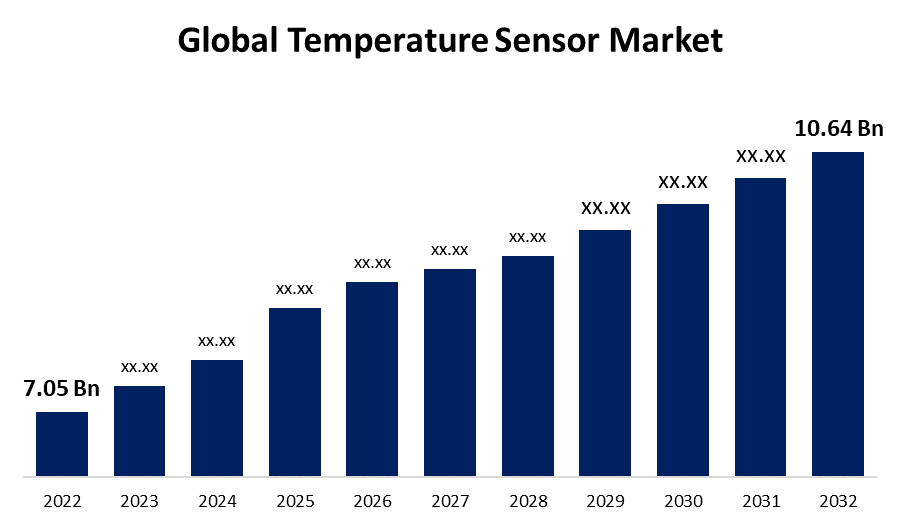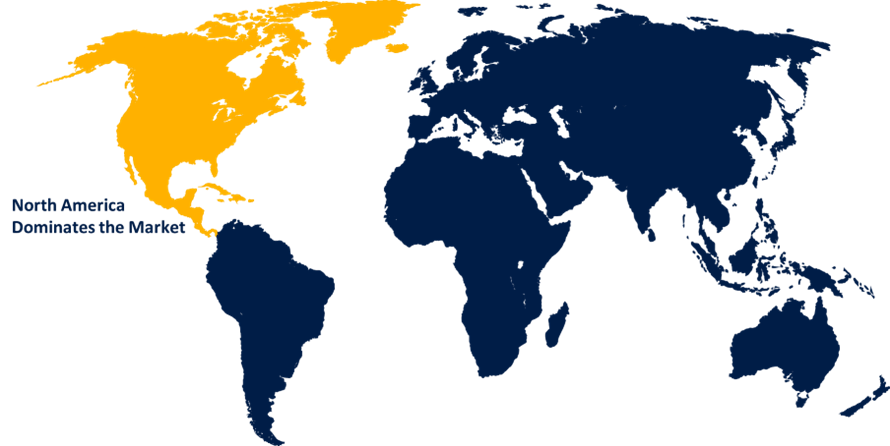Global Temperature Sensor Market Size, Share, and COVID-19 Impact Analysis, By Product (Contact and Non-Contact), By Output (Analog and Digital), By Application (Chemical, Oil & Gas, Consumer Electronics, Healthcare, Automotive, and Others), By Region (North America, Europe, Asia-Pacific, Latin America, Middle East, and Africa), Analysis and Forecast 2022 – 2032)
Industry: Semiconductors & ElectronicsGlobal Temperature Sensor Market Insights Forecasts to 2032
- The Temperature Sensor Market Size was valued at USD 7.05 Billion in 2022.
- The Market is Growing at a CAGR of 4.2% from 2022 to 2032
- The Worldwide Temperature Sensor Market Size is expected to reach USD 10.64 Billion by 2032
- Europe is expected To Grow the fastest during the forecast period

Get more details on this report -
The Global Temperature Sensor Market Size is expected to reach USD 10.64 Billion by 2032, at a CAGR of 4.2% during the forecast period 2022 to 2032.
Market Overview
A temperature sensor is an electronic device designed to measure and monitor temperature variations in various applications. It plays a crucial role in industries such as automotive, aerospace, healthcare, and home automation. Temperature sensors are typically based on various principles, including resistance, voltage, thermocouples, and infrared radiation. They can accurately detect and convert temperature changes into electrical signals, allowing for precise temperature monitoring and control. These sensors come in different forms, such as thermistors, thermocouples, resistance temperature detectors (RTDs), and digital temperature sensors. They find applications in climate control systems, industrial processes, food storage, medical devices, and environmental monitoring. The data collected by temperature sensors is essential for maintaining optimal operating conditions, ensuring safety, and enabling energy efficiency in a wide range of settings.
Report Coverage
This research report categorizes the market for temperature sensor market based on various segments and regions and forecasts revenue growth and analyzes trends in each submarket. The report analyses the key growth drivers, opportunities, and challenges influencing the temperature sensor market. Recent market developments and competitive strategies such as expansion, product launch, and development, partnership, merger, and acquisition have been included to draw the competitive landscape in the market. The report strategically identifies and profiles the key market players and analyses their core competencies in each sub-segments of the temperature sensor market.
Global Temperature Sensor Market Report Coverage
| Report Coverage | Details |
|---|---|
| Base Year: | 2022 |
| Market Size in 2022 : | 7.05 Billion |
| Forecast Period: | 2022-2032 |
| Forecast Period CAGR 2022-2032 : | 4.2% |
| 2032 Value Projection: | 10.64 Billion |
| Historical Data for: | 2018-2021 |
| No. of Pages: | 200 |
| Tables, Charts & Figures: | 110 |
| Segments covered: | By Product, By Output, By Application, By Region |
| Companies covered:: | Ablic, Amphenol Advanced Sensors, Analog Devices, Inc., Osram AG, Dwyer Instruments, Emerson, Hans Turck, Honeywell International, IFM Electronic, Kongsberg Gruppen, Littelfuse, Inc., Microchip Technology Inc., Murata, NXP Semiconductors, Omega Engineering, On Semiconductor Corporation, Pyromation, Renesas Electronics, Rohm Co., Ltd, Sensata, STMicroelectronics N.V., TE Connectivity, Texas Instruments, Vishay Intertechnolog |
| Pitfalls & Challenges: | COVID-19 Empact,Challenges |
Get more details on this report -
Driving Factors
The global temperature sensor market is driven by several factors. The increasing demand for temperature sensors in various industries such as automotive, healthcare, and consumer electronics is one of the primary drivers. The need for precise temperature monitoring in these industries is crucial to ensure safety, reliability, and energy efficiency. Additionally, the growing adoption of IoT devices and automation technologies is driving the demand for temperature sensors in smart homes and industrial automation systems. The rising emphasis on green energy solutions and energy efficiency in manufacturing processes is also driving the demand for temperature sensors. Furthermore, the increasing use of temperature sensors in the healthcare industry for medical devices and diagnostics is expected to drive market growth. Advancements in sensor technology and the development of miniature and wireless sensors are also contributing to the market's growth. Finally, the increasing demand for industrial robotics and control systems is expected to drive the demand for temperature sensors in the coming years.
Restraining Factors
The temperature sensor market faces certain restraints that can hinder its growth. One major restraint is the high cost associated with advanced temperature sensing technologies. The initial investment required for implementing temperature sensors, especially in large-scale industrial applications, can be a barrier for some companies. Moreover, the complexity of integrating temperature sensors into existing systems and the need for calibration and maintenance add to the overall cost. Another restraint is the limited accuracy of certain temperature sensing technologies, which may not meet the stringent requirements of certain industries such as medical and aerospace. Additionally, the availability of counterfeit and low-quality temperature sensors in the market poses a challenge, as they may not provide accurate and reliable temperature measurements. These factors collectively impact the adoption and growth of the temperature sensor market.
Market Segmentation
- In 2022, the non-contact segment accounted for more than 25.4% market share
On the basis of the product type, the global temperature sensor market is segmented into contact and non-contact. The non-contact segment has the largest market share in 2022, this can be attributed to several factors. Non-contact temperature sensors provide several advantages over contact sensors, including remote sensing, minimal interference with the object being measured, and suitability for hazardous or inaccessible environments. These advantages make non-contact sensors ideal for use in industries such as automotive, aerospace, and medical, where precise and contactless temperature monitoring is necessary. Additionally, the increasing adoption of non-contact temperature sensors in consumer electronics, home automation, and smart devices further fuels their market growth. The advancements in infrared and thermal imaging technologies, along with the development of miniaturized and cost-effective sensors, contribute to the growing popularity of non-contact temperature sensing solutions in various sectors. Overall, these factors make the non-contact temperature sensor segment the largest market share holder in the temperature sensor market.
- Consumer electronics is expected to grow at a higher CAGR of 4.8% during the forecast period
Based on application, the global temperature sensor market is segmented into chemical, oil & gas, consumer electronics, healthcare, automotive, and others. The consumer electronics segment is anticipated to experience significant growth in the temperature sensor market in the forecast period. This is due to several factors. The increasing adoption of temperature sensors in smart devices such as smartphones, tablets, wearables, and home automation systems is driving the growth of the consumer electronics segment. Temperature sensors are essential for monitoring the thermal management of electronic components, preventing overheating, and ensuring optimal performance. Moreover, the development of miniaturized and cost-effective temperature sensors has made their integration into consumer electronics devices easier and more affordable. The growing demand for energy-efficient devices and sustainability initiatives also drives the adoption of temperature sensors in consumer electronics. Furthermore, the increasing popularity of smart homes and the Internet of Things (IoT) further fuel the demand for temperature sensors in the consumer electronics sector. Overall, these factors make the consumer electronics segment a promising market for temperature sensors in the forecast period.
Regional Segment Analysis of the Temperature Sensor Market
- North America (U.S., Canada, Mexico)
- Europe (Germany, France, U.K., Italy, Spain, Rest of Europe)
- Asia-Pacific (China, Japan, India, Rest of APAC)
- South America (Brazil and the Rest of South America)
- The Middle East and Africa (UAE, South Africa, Rest of MEA)
North America dominated the market with more than 34.5% revenue share in 2022.

Get more details on this report -
Based on region, North America dominates the temperature sensor market and holds the largest market share. Several factors contribute to its prominent position. The region is home to numerous key players and technological innovators in temperature sensing technologies. It has a robust industrial base comprising sectors like automotive, aerospace, healthcare, and manufacturing, where temperature sensors find extensive application. The region's strict regulatory standards and emphasis on safety and quality control drive the demand for accurate and reliable temperature measurement solutions. Furthermore, North America exhibits a high adoption rate of IoT devices, smart homes, and industrial automation systems, which rely on temperature sensors for monitoring and control. The presence of advanced infrastructure, favorable government initiatives, and significant investments in research and development also contribute to the region's market dominance. Overall, these factors contribute to North America's largest market share in the temperature sensor market.
Recent Developments
In March 2022, Sensirion introduced the STS4x series, its latest generation of temperature sensors. These digital sensors provide exceptionally precise measurements and boast industry-leading lead times. The series offers multiple accuracy classes, with the STS40 model currently representing it. Noteworthy features of the STS4x series include improved signal processing, the availability of three distinct I2C addresses, and communication speeds reaching up to 1 MHz.
Competitive Analysis:
The report offers the appropriate analysis of the key organizations/companies involved within the global temperature sensor market along with a comparative evaluation primarily based on their product offering, business overviews, geographic presence, enterprise strategies, segment market share, and SWOT analysis. The report also provides an elaborative analysis focusing on the current news and developments of the companies, which includes product development, innovations, joint ventures, partnerships, mergers & acquisitions, strategic alliances, and others. This allows for the evaluation of the overall competition within the market.
List of Companies:
- Ablic
- Amphenol Advanced Sensors
- Analog Devices, Inc.
- Osram AG
- Dwyer Instruments
- Emerson
- Hans Turck
- Honeywell International
- IFM Electronic
- Kongsberg Gruppen
- Littelfuse, Inc.
- Microchip Technology Inc.
- Murata
- NXP Semiconductors
- Omega Engineering
- On Semiconductor Corporation
- Pyromation
- Renesas Electronics
- Rohm Co., Ltd
- Sensata
- STMicroelectronics N.V.
- TE Connectivity
- Texas Instruments
- Vishay Intertechnology
Key Target Audience
- Market Players
- Investors
- End-Users
- Government Authorities
- Consulting and Research Firm
- Venture Capitalists
- Value-Added Resellers (VARs)
Market Segment
This study forecasts revenue at global, regional, and country levels from 2019 to 2032. Spherical Insights has segmented the global temperature sensor market based on the below-mentioned segments:
Temperature Sensor Market, By Product
- Contact
- Non-Contact
Temperature Sensor Market, By Output
- Analog
- Digital
Temperature Sensor Market, By Application
- Chemical
- Oil & Gas
- Consumer Electronics
- Healthcare
- Automotive
- Others
Temperature Sensor Market, Regional Analysis
- North America
- US
- Canada
- Mexico
- Europe
- Germany
- UK
- France
- Italy
- Spain
- Russia
- Rest of Europe
- Asia Pacific
- China
- Japan
- India
- South Korea
- Australia
- Rest of Asia Pacific
- South America
- Brazil
- Argentina
- Rest of South America
- Middle East & Africa
- UAE
- Saudi Arabia
- Qatar
- South Africa
- Rest of Middle East & Africa
Need help to buy this report?